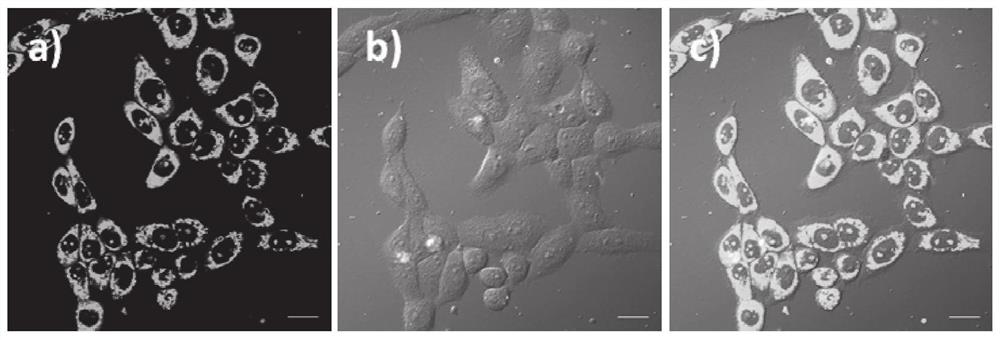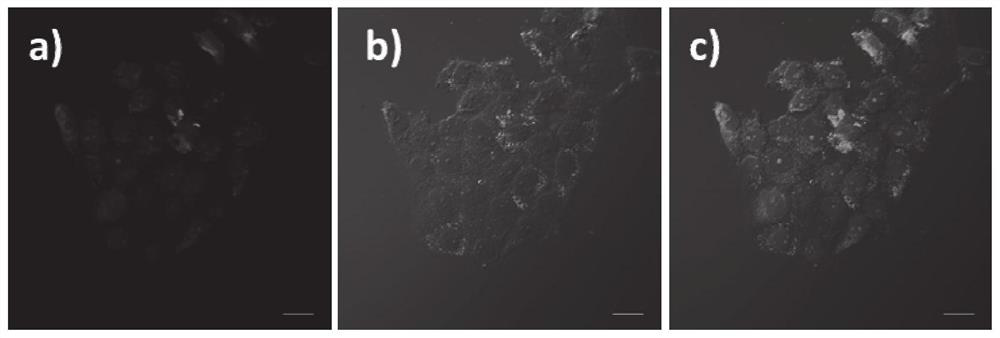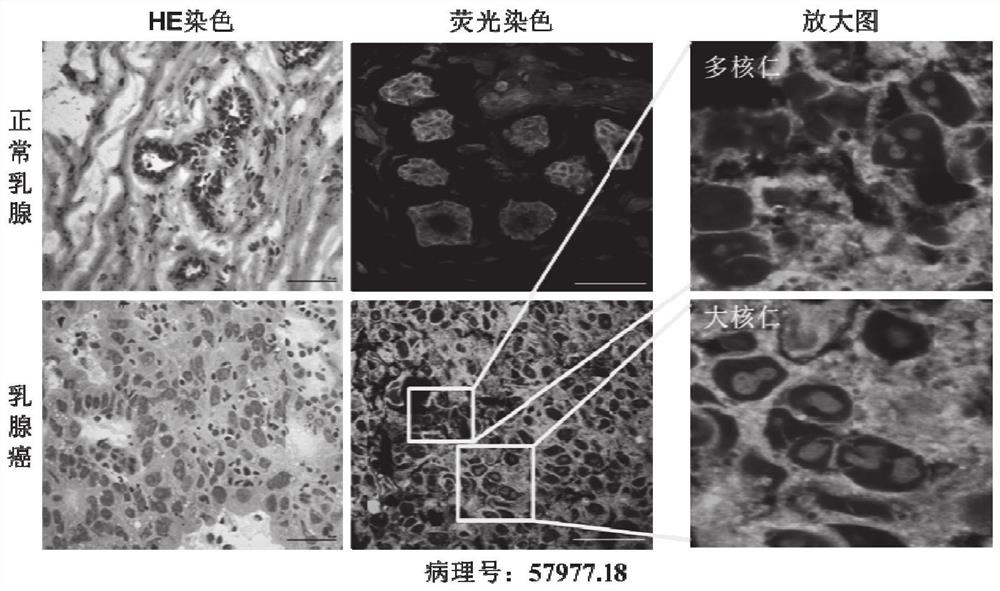RNA fluorescent probe for quickly distinguishing cancer from normal tissues by utilizing morphological changes of nucleolus
A technology of morphological changes and fluorescent probes, applied in the field of fluorescent probes, can solve the problems that the overall outline of the nucleolus cannot be clearly given, the practicability has not been widely verified, and the molecular structure has not been published. It achieves strong photostability, super High permeability and good membrane permeability
- Summary
- Abstract
- Description
- Claims
- Application Information
AI Technical Summary
Problems solved by technology
Method used
Image
Examples
Embodiment 1
[0040] Example 1: Synthesis of probe CAPY-AP.
[0041]
[0042] The specific synthesis is as follows:
[0043] Synthesis of compound 1: 4-methylpyridine (0.93g, 10mmol) and 3-bromopropylamine hydrobromide (2.41g, 11mmol) were dissolved in 20mL of ethanol, and heated under reflux at 85°C for 12 hours. After the reaction, a white solid appeared. After filtering and washing with petroleum ether, pure white compound 1 was obtained. Yield 70%. 1 H NMR (300MHz, DMSO-d 6 ), δ(ppm): 8.938(d, J=6Hz, 2H), 8.047(d, J=6.3Hz, 2H), 7.797(s, 3H), 4.628-4.582(t, J=6.9Hz, 2H) ,2.860-2.794(m,2H),2.622(s,3H),2.220-2.124(m,2H).
[0044] Synthesis of compound 2: under ice bath condition, POCl 3 (9.2mL, 100mmol) was slowly added to dry DMF (7.7mL, 100mmol), and it became viscous after stirring for 30 minutes. Then dissolve in CH 3 Cl N-ethylcarbazole (2.94g, 10mmol) was added into the system, stirring was continued for 1 hour, and the mixture was heated at 80°C for 12 hours. After cooli...
Embodiment 2
[0046] Example 2: SiHa cell culture.
[0047] Adherently culture SiHa cells in culture medium containing 10% fetal bovine serum at 37°C, 5% CO 2 cultured in a saturated humidity incubator, and the medium was changed every 2-3 days for passage. When the cells grow to the logarithmic phase, culture the slices: ① Soak the coverslips in absolute ethanol for 30 minutes, dry them with an alcohol lamp and place them in a disposable 35mm culture dish for later use; Wash the cells three times with PBS, digest with 1mL 0.25% trypsin for 3-5 minutes, pour out the trypsin carefully, add fresh culture medium and pipette evenly, and count the cells. The concentration is 1×10 per ml 5 , and then inoculated into the above-mentioned petri dish containing the coverslip in 5% CO 2 Cultured in an incubator to allow the cells to grow on the sheet. After the SiHa cells grow on the slide and cover the glass, it is used for the experiment.
Embodiment 3
[0048] Example 3: Staining observation of active SiHa cells by probe CAPY-AP.
[0049]First prepare 5mM probe CAPY-AP in DMSO solution as mother solution. After the SiHa cells were covered with coverslips, remove the medium in the culture dish, wash the coverslips containing SiHa cells with clean PBS for 3 times, stain the cells with 5 μM CAPY-AP, and store in CO 2 Incubate in the incubator for 30min. Take out the stained slides, wash away the excess probes, cover the cell growth side down on the glass slide, and observe the coloring position, fluorescence distribution and brightness of the cells under a laser scanning confocal fluorescence microscope (using 488nm laser to irradiate the cells) change etc.
[0050] see results figure 1 . Among them, figure a is the photo of the probe CAPY-AP under excitation of 488nm, collecting the green channel of 500-600nm, figure b is the differential interference micrograph of bright-field laser scanning, and figure c is the merged fig...
PUM
 Login to View More
Login to View More Abstract
Description
Claims
Application Information
 Login to View More
Login to View More - R&D
- Intellectual Property
- Life Sciences
- Materials
- Tech Scout
- Unparalleled Data Quality
- Higher Quality Content
- 60% Fewer Hallucinations
Browse by: Latest US Patents, China's latest patents, Technical Efficacy Thesaurus, Application Domain, Technology Topic, Popular Technical Reports.
© 2025 PatSnap. All rights reserved.Legal|Privacy policy|Modern Slavery Act Transparency Statement|Sitemap|About US| Contact US: help@patsnap.com



